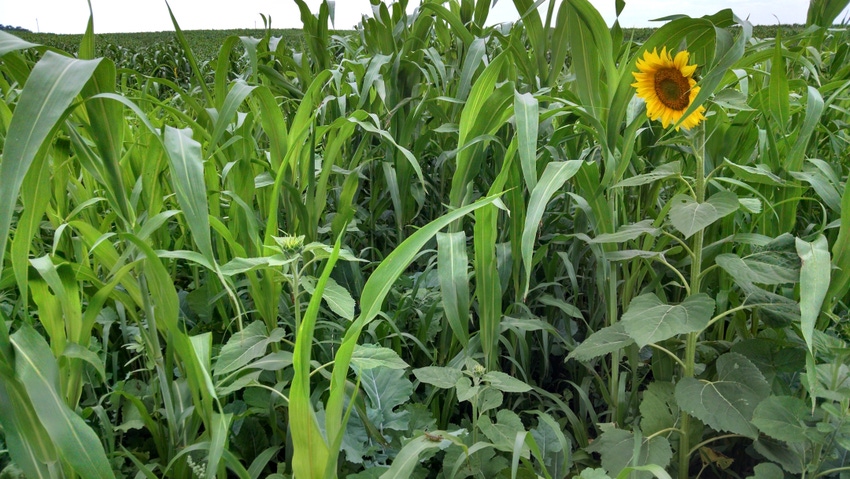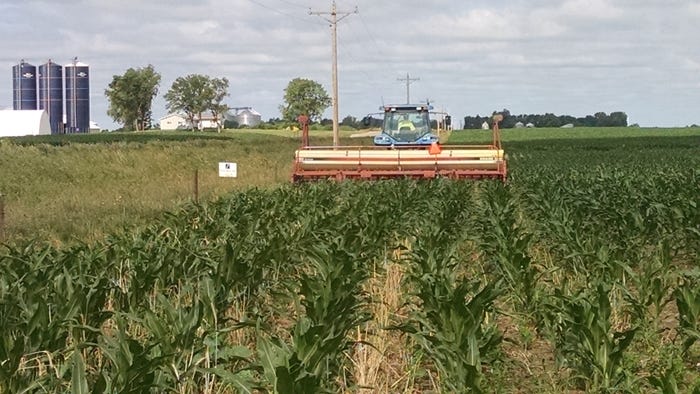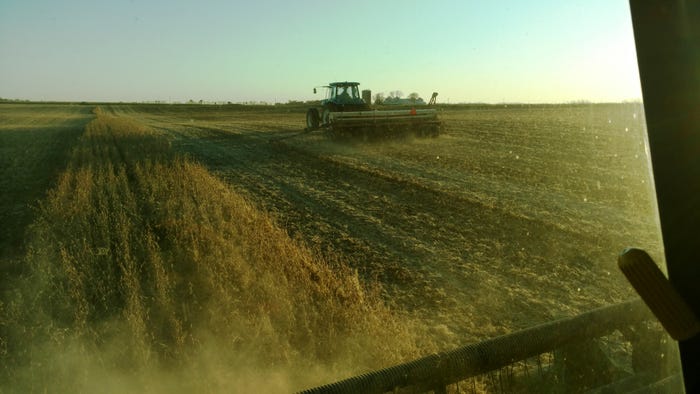June 29, 2018

Think Different
Grant and Dawn Breitkreutz are quick to acknowledge their transition hasn't been quick, nor has it been simple. A few simple rules have helped.
Question every practice.
Consider alternatives.
Seek out mentors and positive feedback.
Be ready to change to make things work.
---------
Grant and Dawn Breitkreutz plant conventional corn and public variety soybeans, haven't sprayed for aphids in three years and aren't seeing herbicide resistant weeds on their 360 acres of cropland. The 100% no-till, west central Minnesota farmers credit crop rotation, cover crops and cattle for improved soil health. The farm's biodiversity fights pests, feeds the crops and is allowing Breitkreutz to reduce costly inputs more every year.
"Reducing input costs makes farming fun again," says Grant Breitkreutz. "Our goal is to eliminate buying non-seed inputs altogether."
While not yet there, the farm keeps getting closer. Thanks to cover crops and the manure from 180 brood cows and a 200-head feedlot, he has grown corn the past two years on 1/3 pound of purchased nitrogen per bushel. It is a program that’s been 20 years in the making and is still being refined. Breitkreutz credits his wife Dawn for instigating many of the changes.

A diverse mix of 14 to 17 species is planted in mid-summer after harvesting a forage crop of oats, peas and barley. By fall, the thick biomass provides ideal grazing for freshly weaned calves. Dawn Breitkreutz notes that it makes a tremendous feed source for starting the calves on their own.
A more open mind
"She is a city girl who has always worked alongside me. We make decisions together," says Breitkreutz. "She would ask why we were doing a particular tillage pass or using an herbicide or other practice. It made me think about and question the need and keep my mind open to new ways."
One of the first changes was no-tilling soybeans 20 years ago and, at the same time, planting triticale after chopping corn silage. The goal was grazing for the cow herd, but almost immediately, Breitkreutz started seeing soil health benefits.
Use of cover crops gradually increased in intensity and diversity, particularly over the past seven or eight years, as did no-tilling. For the past four years, they have cover crops on every acre of the farm, tilled zero acres and grazed all of it. Cover crops are so woven into the operation that it is hard to say when they start and when they stop. Corn and soybeans are no-till planted into terminated green cover crops.
"We like to interseed corn at V5 to V6 with three legumes, three brassica and three grasses," says Breitkreutz. "Soybeans are solid seeded, so we have to wait until harvest to plant a cover crop. We seed winter rye into soybean stubble while making the last passes with the combine."

Grant Breitkreutz pulls every third unit out of his no-till, Krause grain drill and uses it to interseed a 3-3-3 cover crop mix into corn at V5/V6. The three legumes, three brassica and three grasses build soil health and provide valuable fall and early spring grazing for his 180 head cow herd.
Diverse crop rotation
Acres generally are rotated from corn to soybeans and then to winter wheat or winter rye, always with cover crops in between. The winter grains spread out the workload, benefit the soil and allow Breitkreutz to plant a diverse mix of covers for fall grazing. While some of those acres will go back into corn the following year, most will be seeded to an early spring crop of oats, peas and barley.
Winter grains are harvested as grain, but the spring grains are cut for silage or hay. Those acres are replanted to a full-season, mixed bag of as many as 17 species of legumes, brassicas, grasses and more. Breitkreutz will add sunflowers for their deep roots and buckwheat to attract pollinators. While he weans his calves on these acres in the fall, his return is calculated on more than just pounds gained by the calves.

Corn is planted green in standing cereal rye. Grant and Dawn Breitkreutz aim for maximum biomass before terminating with a burndown and Dual after the corn germinates, but before it emerges. The combination of Dual and heavy thatch mulch gets the credit for weed free corn. If necessary, Clarity serves as a clean-up treatment.
Key to every cover crop mix is seeding some varieties that overwinter. Breitkreutz depends on the thick thatch left after burndown to help hold down weeds, reduce herbicide inputs and capture nitrogen from legume cover crops and manure spread the previous year. He credits the allelopathic rye in the mix for keeping waterhemp out of the fields.
Soybean acres get a single pass of Flexstar Fusion, while corn usually receives nothing beyond Dual applied with the burndown to the cover crop. Breitkreutz waits five days after planting corn to terminate the rye.
"We've had really good luck doing this the past five years," says Breitkreutz. " If necessary, we may come back with some Clarity."
No seed traits needed
"We're also getting significant soil health improvement and more beneficial insects," says Breitkreutz. "The four-crop rotation combined with cover crops has allowed us to go back to conventional seed, which saves at least $50 to $60 per acre on seed corn alone. We don't need the traits or many chemical inputs because we don't have insect or weed pressure."
While he does spray if pests reach their economic threshold, Breitkreutz hasn't sprayed for soybean aphids for the past three years. "I scout for aphids, but when I open up the canopy, it is alive with insects I've never seen before," he says. "The lack of aphids tells me many, if not all, are beneficials."
Breitkreutz also credits his rotation and covers with elimination of soybean cyst nematodes (SCN). "We were at the point where we either planted SCN resistant soybeans or none at all," he recalls. "After six years of cover cropping, we have no SCN. We plant public varieties with no regard for resistance and at a lower cost."
Content with yields that hit the county averages, Breitkreutz points to longer-term benefits of the holistic approach. In addition to reduced inputs, organic matter levels have risen substantially, going from the upper twos and lower threes to over 4%, with one piece of ground going from 1.8% to 4.8%. Soil structure has also improved dramatically.
No more rain delays
"We don't have rain days anymore," says Breitkreutz. "Water infiltration on our fields varies from six inches per hour to more than 30 inches/hr. You can go across the neighbor's fence, and the rate will be an inch or less."
In addition to his wife's questioning of accepted ag dogma, Breitkreutz cites mentors like Gabe Brown, livestock and soils consultant Allen Williams, Holistic Management International and others for helping the farm find its path. That's not to say the path will continue as it has. Breitkreutz puts a high value on flexibility.
"One reason we plant every acre to a cover crops that will green up in the spring is that it gives us the option of grazing or planting corn or soybeans," he says. "Looking ahead, we may get better dollars with cattle on covers than planting either crop."

No-till drilling cereal rye into solid seeded soybean stubble is well under way before the combine even leaves the field. The rye will provide valuable cover over winter and green up in the spring.
While cattle are central to his operation, Breitkreutz is confident the combination of no-till, cover crops and crop rotation would work even without them. "I just don't think the transformation of the soil would go as fast without livestock," he says.
About the Author(s)
You May Also Like




